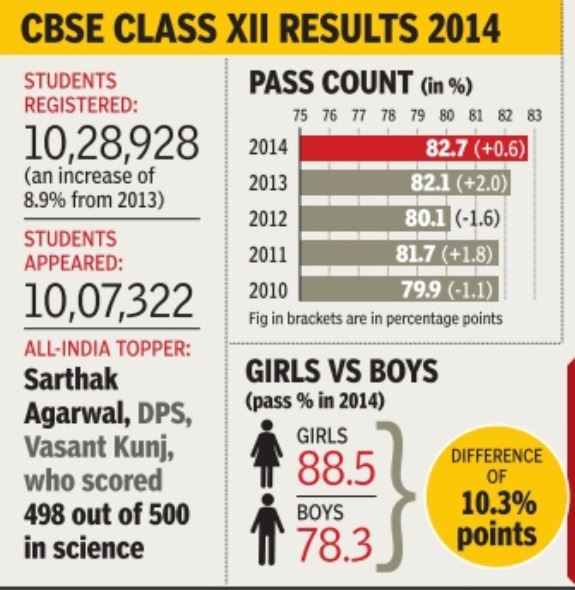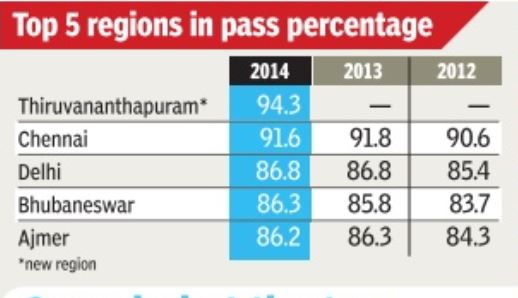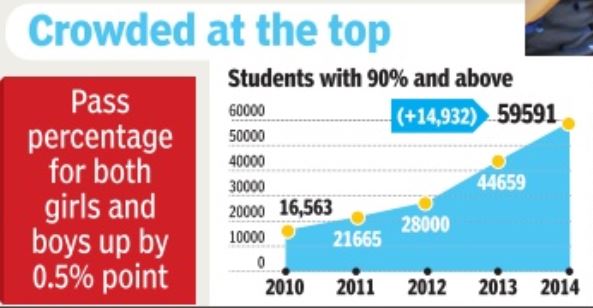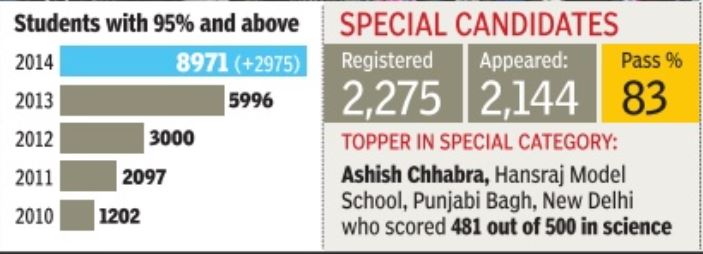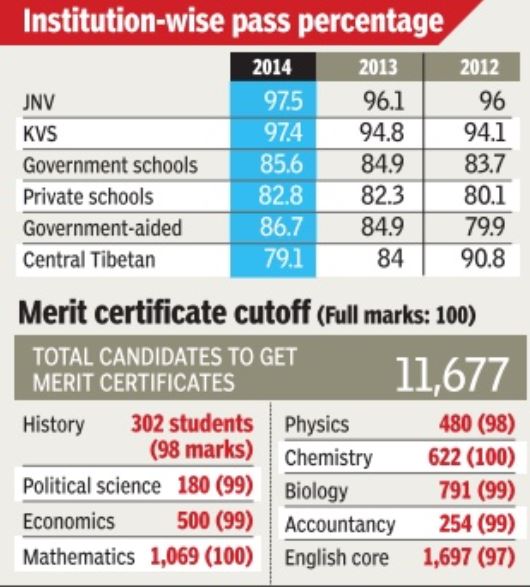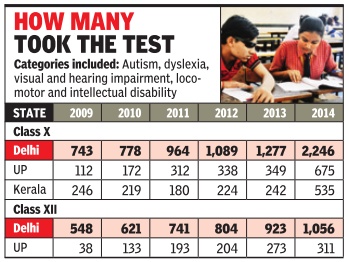Central Board of Secondary Education (CBSE)
(→Growth in affiliations: 1996-2013) |
(→Safety of school children) |
||
| Line 56: | Line 56: | ||
School authorities will also have to provide one mobile phone in each bus and ensure that the buses are not permitted to overtake any four-wheeler while carrying children. | School authorities will also have to provide one mobile phone in each bus and ensure that the buses are not permitted to overtake any four-wheeler while carrying children. | ||
| + | |||
| + | = Re-evaluation policy= | ||
| + | == Students can seek re-evaluation in all subjects: HC== | ||
| + | [http://epaperbeta.timesofindia.com/Article.aspx?eid=31808&articlexml=Change-re-evaluation-norms-for-CBSE-HC-05022017004028 Abhinav Garg, No Cap, Students Can Opt For All Subjects, Feb 05 2017: The Times of India] | ||
| + | |||
| + | |||
| + | In an important verdict, the Delhi high court has struck down the Central Board of Secondary Education's selective re-evaluation policy that restricted students from availing the option in just 10 subjects and 10 questions per subject. | ||
| + | |||
| + | Spelling relief for students, a division bench comprising Chief Justice G Rohini and Justice Sangita Dhingra Sehgal termed the restrictions as “eccentric“ and said students can now seek re-evaluation in all subjects. | ||
| + | |||
| + | “It is rather eccentric to first provide for the facility of re-evaluation to the candidates and thereafter put unreasonable restrictions. The board cannot afford to ignore individual claims of re-evaluation at its whims or fancy , by merely `pick and choose' of subjects or number of questions,“ the bench observed while ruling in favour of two students. | ||
| + | |||
| + | The board had introduced a rule in its examination scheme to allow students to apply for re-evaluation, but restricted the number of questions and the subjects to be re-evaluated. By way of a notification in May 2015, CBSE brought out these rules after amending the by-laws, which the court found to be “manifestly unjust, unreasonable and partial“. | ||
| + | |||
| + | Pointing out the pitfalls of CBSE continuing with such a rule, the bench observed that it “would lead to discontentment and frustrations if the students who put in a lot of effort do not get the results they expect“ adding that “it should be the students' prerogative to get their answer sheets re-evalua ted in order to ensure proper assessment is done“. | ||
| + | |||
| + | In the process, the court upheld two separate single-judge verdicts. In one a single judge had faulted CBSE for allowing just 10 questions for re-evaluation, while the second bench ordered it to re-evaluate a student's physical education theory paper, despite the board claiming that PE is not covered under its subjects where re-look is permitted. | ||
| + | |||
| + | The board argued before the division bench that it sto res lakhs of copies after the examination, as many students apply for re-evaluation. Defending its restriction on number of questions and number of subjects, CBSE maintained it had to exercise some discretion, else will be flooded with such requests. It even cited certain Supreme Court judgments, to bolster its argument that it has the power to deny reevaluation of answer sheets. | ||
| + | |||
| + | However, the HC rejected its stand and noted that administrative difficulties of the board can't over-ride the future of a candidate. | ||
| + | |||
| + | CBSE had decided to scrap the re-evaluation of class XII answer sheets in 2016 and the court order is a setback. In 2014 it introduced re-evaluation in eight subjects, which it extended to 10 in the subsequent year, becoming the only board to facilitate this service. | ||
| + | |||
| + | There is a three step process wherein the student first needs to apply for recounting of marks if in doubt and thereafter he she can ask for the photocopy of the evaluated answer sheets. If not satisfied, the third step is re-evaluation of the answer sheet. All the three steps are linked and a student can't ask for re-evaluation without following the preceding two steps. | ||
=Appointment of Principal= | =Appointment of Principal= | ||
Revision as of 12:58, 31 March 2017
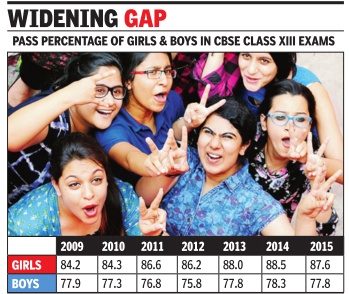
This is a collection of articles archived for the excellence of their
content. You can update or correct this page, and/ or send graphs to the Facebook page, Indpaedia.com. All information used will be duly acknowledged. |
Contents |
Growth in affiliations: 1996-2013
No. of CBSE schools triple in 17 yrs
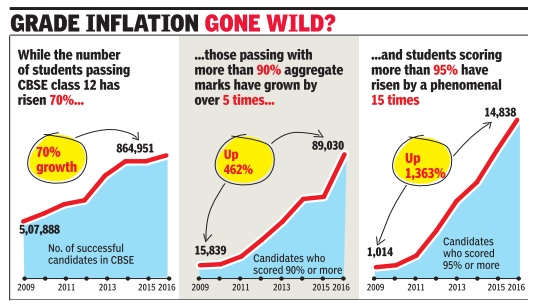
Hemali Chhapia Shah & Vinamrata Borwankar Mumbai:
TNN The Times of India Jun 18 2014
Almost half-a-dozen school boards—local, national and international—offer Indian students a choice of academic algorithms for careers ahead. The landscape of school education has for long promised a variety of options.
But of them all, CBSE (Central Board of Secondary Education), which was largely designed for those who moved home and could not be loyal to a state board, is picking up popularity across the nation.
In 1996-97, there were 4,843 affiliated schools to the CBSE board, which has grown to
15,000 institutes now, with most of the growth attributed to independent private schools, indicating the way the wind is blowing. While every year thousands of Indian parents find it tough to decide which board their child must sign up for, new school managements too face the same quandary when they start operations.
CBSE officials and school principals attribute the board’s popularity to its academic and administrative reforms which are student and school friendly. “Close to 98% of the schools that apply for affiliation are new institutes,” said an officer. Since 2005, the affiliation process is online and information at every stage is sent via electronic mail. “Also, the board is a national board, allowing parents to shift to just about anywhere in the country. The NCERT syllabus is also the most modern and wholesome one which is in tune with the times,” said a
CBSE administrative officer.
Little wonder then that in 2001-02 there were 6,293 affiliated schools, a number which increased to 13,898 in March 2012-13. Most of the growth came from independent institutes, the count of which went up from 3,483 in 2001-02 to 10,290 by the end of 2013.
Delhi has the largest number of CBSE schools, followed by UP, Haryana and Kerala.
Maharashtra, which has seen a 67% increase in the number of CBSE schools in the last three years, is home to over 500 institutes. “We have introduced and successfully implemented the continuous comprehensive evaluation system.
Norms for affiliated schools
Safety of school children
All school buses must now have speed governors dictating a limit of 40 km per hour, GPS and CCTV cameras, the Central Board of School Education (CBSE) directed in new guidelines for safety of school children issued.
Stating that the norms “should be scrupulously followed and complied with by all affiliated schools“, the board stated that the management and the head of the school will be held responsible for any lapse which could lead to disaffiliation.
The CBSE divided the guidelines into seven categories which include exterior and interior of the bus, manpower and facilities, permits, arrangements by school authorities and advisory to parents.
The CBSE in its circular stated that “the recent unfort unate instances reported in the media about callous approach by certain schools with respect to safety of children during transit to and from school have again agitated deep concern regarding the safety of schoolchildren. The time has come to make schools sensitive to this serious issue.“
On the buses' exterior, the Board said buses should be pa inted yellow with the school name prominently on both sides. `School bus' should be written prominently on the back and front of the vehicle and if it is a hired bus, “On school duty“ should be clearly written.
The board also stated that the driver's name, address, licence number, badge number and the telephone number of the school or bus owner and transport department's helpline numbers should be displayed at prominent places inside and outside the bus. In the buses' interiors, windows will have to be fitted with horizontal grills and mesh wire, and doors with reliable locks.
School authorities will also have to provide one mobile phone in each bus and ensure that the buses are not permitted to overtake any four-wheeler while carrying children.
Re-evaluation policy
Students can seek re-evaluation in all subjects: HC
Abhinav Garg, No Cap, Students Can Opt For All Subjects, Feb 05 2017: The Times of India
In an important verdict, the Delhi high court has struck down the Central Board of Secondary Education's selective re-evaluation policy that restricted students from availing the option in just 10 subjects and 10 questions per subject.
Spelling relief for students, a division bench comprising Chief Justice G Rohini and Justice Sangita Dhingra Sehgal termed the restrictions as “eccentric“ and said students can now seek re-evaluation in all subjects.
“It is rather eccentric to first provide for the facility of re-evaluation to the candidates and thereafter put unreasonable restrictions. The board cannot afford to ignore individual claims of re-evaluation at its whims or fancy , by merely `pick and choose' of subjects or number of questions,“ the bench observed while ruling in favour of two students.
The board had introduced a rule in its examination scheme to allow students to apply for re-evaluation, but restricted the number of questions and the subjects to be re-evaluated. By way of a notification in May 2015, CBSE brought out these rules after amending the by-laws, which the court found to be “manifestly unjust, unreasonable and partial“.
Pointing out the pitfalls of CBSE continuing with such a rule, the bench observed that it “would lead to discontentment and frustrations if the students who put in a lot of effort do not get the results they expect“ adding that “it should be the students' prerogative to get their answer sheets re-evalua ted in order to ensure proper assessment is done“.
In the process, the court upheld two separate single-judge verdicts. In one a single judge had faulted CBSE for allowing just 10 questions for re-evaluation, while the second bench ordered it to re-evaluate a student's physical education theory paper, despite the board claiming that PE is not covered under its subjects where re-look is permitted.
The board argued before the division bench that it sto res lakhs of copies after the examination, as many students apply for re-evaluation. Defending its restriction on number of questions and number of subjects, CBSE maintained it had to exercise some discretion, else will be flooded with such requests. It even cited certain Supreme Court judgments, to bolster its argument that it has the power to deny reevaluation of answer sheets.
However, the HC rejected its stand and noted that administrative difficulties of the board can't over-ride the future of a candidate.
CBSE had decided to scrap the re-evaluation of class XII answer sheets in 2016 and the court order is a setback. In 2014 it introduced re-evaluation in eight subjects, which it extended to 10 in the subsequent year, becoming the only board to facilitate this service.
There is a three step process wherein the student first needs to apply for recounting of marks if in doubt and thereafter he she can ask for the photocopy of the evaluated answer sheets. If not satisfied, the third step is re-evaluation of the answer sheet. All the three steps are linked and a student can't ask for re-evaluation without following the preceding two steps.
Appointment of Principal
December 2016: CBSE gets a say in unaided schools
Manash Gohain, CBSE gets say in picking heads of unaided schools, Dec 23, 2016: The Times of India Private unaided schools affiliated to the Central Board of Secondary Education (CBSE) will no longer be able to appoint principals or heads on their own as the board has empowered itself to monitor such appointments in schools that fall under its ambit. Also, teachers aspiring to be principals will now have to qualify a Principal Eligibility Test (PET) conducted by the board, a circular said.
According to a CBSE circular issued to all state education directorates, school principals and other stakeholders, it will now be mandatory for schools to include a CBSE nominee and a state government nominee in their selection committees for principals.
Further, these committees will have to comprise five or more members instead of the four that were required till now, the new addition being that of the state government nominee. What makes this change significant is that the member with experience in school administration, hitherto nominated by schools' managing committees, will now be nominated by the chairperson of the CBSE.
This effectively means that out of the five members on the panel, two will be appointed directly by , or with the approval of, the CBSE.“Till now, it was the managing committee which used to independently pick the two, with the president of the society and the managing committee chairperson being the remaining two constituents. In case of pri vate unaided schools, the recruitment used to be completely in the hands of the school management,“ said a member of the central board's governing body .
Voicing concern at the apparent curtailment of autonomy , a principal of a private school in Delhi said on condition of anonymity , “This effectively creates a controlled regime. We don't really know how reducing schools' members in the selection committee will help them. The strength and kind of candidates vary from school to school. For that there should have been more autonomy . The CBSE and state government nominees are welcome, but that may result in delays.“
Class XII results: historical trends
CBSE is India's Central Board of Secondary Education
Disabled candidates
Jan 05 2015
Most disabled kids in CBSE exam from city
Shreya Roychowdhury
The largest number of disabled candidates appearing for classes X and XII evaluation under Central Board of Secondary Education (CBSE) is from Delhi.The state-wise count of students with disabilities, released by the Board also showed that the number of differently-abled students appearing for evaluation has been rising steadily . A total of 743 candidates appeared in Class X exam in 2009 in Delhi and more than double the figure appeared in 2014. There were no registrations of autistic students in Class X from 2009 to 2013 from Delhi, but there were five in 2014. Similarly, numbers of students with visual impairment or dyslexia have also increased significantly over the six years -from 214 to 403 in case of blind students and from 93 to 423 in case of those with dyslexia. For the Class XII exam, the biggest jump was in case of orthopedically challenged students. CBSE categorizes them as “handicapped“. In 2009, 272 mobility-impaired candidates from Delhi appeared for Class XII evaluations; the figure rose to 524 in 2014. The number of hearing-impaired students jumped from 25 in 2009 to 130 in 2014.
One of the reasons for the huge difference between Delhi and runners-up Uttar Pradesh, Kerala and Madhya Pradesh is that in Delhi majority of schools are CBSE-affiliated. There is no state board and government schools too come under CBSE.
“Inclusive education is strong in Delhi,“ George Abraham of NGO Score Foundation said adding, “There are more visually challenged students in mainstream schools in Delhi than in any other place in the country. It also depends on the support services, availability of reading material and trained teachers. Delhi is more education-friendly, more aware,“ he said. “Even CBSE is good at handling things here as regional officers are always well-equipped.“ He recalled the case of a student in Surat who was not allowed to use a computer to write his exam.“They were telling him to go to Ajmer. We managed it, but regional offices are not necessarily in sync with the headquarters.“
Madhumita Puri of Society for Child Development, Delhi, said most of the students who have been successfully appearing for these exams are either from private schools or from National Institute of Open Schooling (NIOS). “Sarva Shiksha Ab hiyan has helped and so has stricter implementation of 3% reservation in jobs,” Puri said, “The well-to-do always send their disabled children to school. Now, poor parents too have been making an effort.”
In case of Delhi, the number of students, who appeared for CBSE evaluation in Class X, is close to the num ber appearing in Class XII two years later.
A total of 743 students appeared in Class X evaluation in 2009 and 741 appeared in Class XII exam in 2011. Either the attrition rate is low with those completing Class X choosing to remain in school, or students from other states, where there is a dip in number, are moving in to Delhi.Puri said, “There is a huge migration of visually-impaired students into Delhi, but very little in the other categories.“
2014: Top scoring subjects
The Times of India, Aug 30 2015
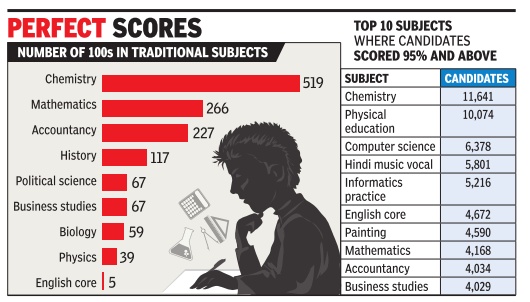
Manash Gohain Chemistry was a cakewalk for students at the Class XII Boards this year. Data on subject-wise scoring pattern from the Central Board of Secondary Education, exclusively accessed by TOI, revealed that not only were a maximum number of 100s scored in chemistry but that over 11,000 candidates also got 95% and more in the subject. The trend of high scores have continued with the number of 100s this year crossing 2,300, up from over 1,900 in 2014. The data also debunked the myth that it's easier to score in vocational electives. Mathematics, English, accountancy and business studies were among the top 10 subjects in which students scored a perfect 100 as well 95% and above. Another highlight: As many as 117 notched up a perfect score in history--a larger figure than physics, biology or business studies this year.
According to CBSE sources, the number of 100s scored among the traditional subjects--chemistry , physics, biology , mathematics, English, accountancy, business studies, history and political science--this year is 1,366. This is despite claims by schools and students that the physics and mathematics papers have been the “toughest“ in a decade. A total of 266 students scored 100 in mathematics and 39 did the same in physics.
The number of candidates scoring 95% and above in individual subjects has also been significant. Candidates have scored 95% and above in 95 subjects out of the total of 193 subjects offered by CBSE at the senior secondary level.
“In all mainstream subjects and well as in popular subjects, students seem to have performed well. Subjects like economics, Hindi core, history, political science, geography are also among the top subjects in which more than a thousand candidates have scored 95% and above. There are 10 subjects in all in which over 4,000 candidates scored 95% and above,“ said a senior official.
One of the reasons for the spike is the grace marks doled out. “Grace marks is nothing new, but this year it has been a bit on the higher side,“ said another CBSE official.
2015: CBSE exam pattern adopted
The Times of India, Nov 21 2015
CISCE rejigs syllabus, follows CBSE exam pattern
The Council for the Indian School Certificate Examination (CISCE) board revamped its syllabus, infrastructure and training methods, with an objective of centralising education. At its 58th annual meeting, the board decided to frame class 12 (ISC) question papers based on the CBSE pattern from 2018. Sample question papers for the ISC exams in 2018 for physics, chemistry , biology and math have been prepared as per the CBSE pattern. For class 10 (ICSE), the syllabus for history , civics, geography , math and physics has been reviewed for 2018. This is to ensure it is relevant, flexible and meaningful in content.
The break-up of marks of the theory and practical components at the ISC level has been revised for the following subjects: Computer science, fashion designing, physical education, Indian music (Hindustani), Carnatic and Western music. The earlier figures of 50% (theory) and 50% (practical) have been changed to 70% and 30%, w.e.f 2016.
The sample papers for these subjects have already been sent to schools and are also available on the council website.
2016
Class X
The Times of India, May 29 2016
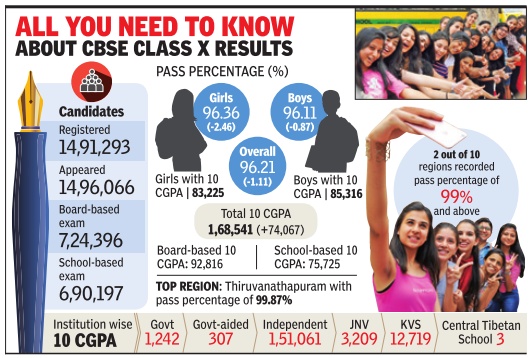
Manash Gohain
The capital had little to cheer about after the CBSE Class X results were declared on Saturday as it recorded the second-lowest pass percentage of 91.76% among all 10 regions. Thiruvananthapuram (99.87%) held on to the top spot. Overall, the pass percentage fell a point from 97.32% last year to 96.21%, though the number of those scoring a cumulative grade point average of 10 crossed the 1 lakh mark for the first time.
Girls outshone boys, albeit by a tiny fraction, after the latter had overtaken them last year. Among the girls, 96.36% cleared the exams compared with 96.11% of the boys. However, the boys held the edge in scoring high grades, with 85,316 of them logging a CGPA of 10 against 83,225 girls scoring the highest grade.
In fact, the number of those obtaining the highest CGPA of 10 rose 40% from that of 2015. A CGPA of 10 represents all those obtaining aggregate marks of 95% or above. For the first time, the number of students crossing the coveted mark went beyond 1lakh, with 1,68,541candidates eventually getting a CGPA of 10. With the introduction of continuous and comprehensive evaluation since 2009, the Class X board exams have become optional. This year, nearly 52% of the candidates opted for the school-based exam. This also means that students wanting their answer scripts to be verified would have to apply separately according to the exam they sat for. According to K K Choudhury , controller of examination, CBSE, students who took the school-based exam would have to apply for verification of grades at their respective schools. For those who took the board-based exam, applications are to be made online within seven days from the declaration of results.
Interestingly, students with a CGPA of 10 outnumbered those getting any other grade. While last year, 7.1% of the candidates had got to a CGPA figure of 10, the number went up to to 11.91% this year. Candidates from private school continued to lead the pack of top scorers with 89.62% of CGPA 10 scorers, a marginal improvement over last year's 89%.
Regionwise, Thiruvanan thapuram again led at the top with a pass percentage of 99.87%. Chennai is the only other region with 99% and above pass percentage among the 10 regions.
The number of attempts permitted for the improvement of grades in Class X has been reduced to one from five since 2013. Candidates can appear for the improvement exam in July .
Of a total of 3,510 diabled candidates, 3,335 qualified with a pass percentage of 95.18%. The server was down for nearly 40 minutes as soon as the results were released.
Class XII
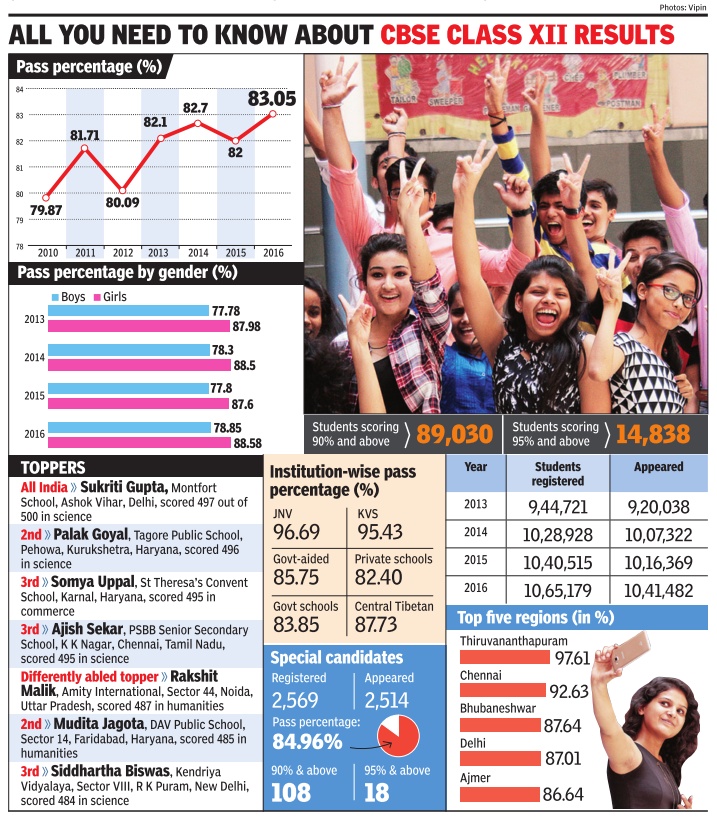
Delhi’s performance
The Times of India, May 22 2016
Delhi pass percentage better, but slips to 4th
Delhi's pass percentage, 87.01%, is better than the national average and is even an improvement over 86.13% in 2015. However, on the list of regions, the national capital has slipped to the fourth position from the third slot it got in 2015.
Governments schools have once again had a higher pass percentage than private ones--88.98%--against 86.67%. Both groups have seen slight improvement in performance compared with last year. Girls have done better than boys this year too. Besides, Kendriya Vidyalayas have outperformed others.
The national top-scorer in science is from Delhi; as is one of the top-three in the differently-abled category , but on the whole, many private schools may have seen a slight dip in average scores thanks to disappointing maths scores and wide variations in subjects such as economics and political science.However, there are still dozens with aggregate scores at or above 95%. Amity International, Mayur Vihar, has 65; Delhi Public School, Vasant Kunj has 63; DPS Dwarka, 57; Sardar Patel Vidyalaya, 35; Springdales School, Pusa Road, 27; Birla Vidya Niketan, Pushp Vihar, 25; Amity Saket, 18; Ahlcon International School, Mayur Vihar has 15; Mount Abu Public School, Rohini, has 11; and Manav Sthali School, five. There is a last number who've scored above 90% too; DPS RK Puram alone has over 500 of them.
Full marks are rarer in some subjects this year but still present in spades. The Indian School has 13 kids who've scored full marks in a subject. Springdales, Pusa Road has 11; and Ahlcon International, nine. “This is extraordinarily good,“ said Tania Joshi, principal, The Indian School, adding that there were “wide variations in performance“ in several subjects.
The CBSE hasn't released the name of the top rank holder for humanities. The humanities topper for Delhi isn't available either but Tarang Kaur of DPS RK Puram, with an aggregate of 98.2%, is a likely candidate.Ayush Srivastava of Amity International, Mayur Vihar, has come close to the top score in science with 98.6%.
It has been a decent year for economically weaker section candidates as well. Nida Khanam, daughter of an imam and supported by the alumni of the Modern School, Barakhamba Road, has scored 95.6% in the board exams. “My family has had to face a lot of crisis all through the years. Before this, I studied in a government school and always topped. But unlike that school, there was a high level of competition here,“ said Nida. She has scored a 99% in English.
KVs and JNVs continue to excel
The Times of India, May 22 2016
KVs and JNVs lead the pack with maximum passing out
The two central government-backed school chains, Kendriya Vidyalayas (KVs) and Jawahar Navodaya Vidyalayas (JNVs) continue to excel when it comes to pass percentage in the exams conducted by the Central Board of Secondary Education (CBSE).
In 2016 too they led the pack in the “best pass percentage“ category . Also, one of the toppers in the differently-abled category is from the KV system. CBSE XII results were announced.
In 2016, 70,328 students from KVs appeared for Class XII exams as against 27,413 from JNVs. JNVs recorded a pass percentage of 96.69%, a marginal drop from 96.82% recorded in 2015. Institutionwise, KVs recorded the second best pass percentage with 95.43%, up from last year's 94.72%. Siddhartha Biswas from KV , R K Puram Sector VIII scored 484 out of 500 in science.He is one of the toppers in the differently-abled category .
While the pass percentage of other institutions was hovering around 80s, the KVs and JNVs had breached the 90%mark way back in 2009. In fact, KVs and JNVs recorded 97.4% and 97.5%, respectively , in 2014, which is so far their best performance.
Caste-category wise performance
The Times of India, May 22 2016
Kshitiz Gaur
Only 1,827 ST girls took XII exams
For the first time, the CBSE declared results of the Class XII board examinations offering castebased data. Students were divided into general, SC, ST and OBC (Other Backward Caste) categories.
Educationists were surprised by this novelty. Not surprisingly, the best performers were from the general category. The data released by the board also showed that only 1,827 girls from Scheduled Tribes took the examination this year.
The results showed that 88% of students in the general category passed; 82.60% of Schedule Caste students and 82.70% of Other Backward Castes candidates secured pass marks.Only 80.50% of students of Schedule Tribes managed to pass. Some board officials, who too wished to remain anonymous, told TOI that the caste data of examinees would aid in comparing the educational performance of different social categories.
Class X
Boards again from March 2018
The Times of India, Dec 21 2016
CBSE Std X board exam will be back from March 2018
The governing body of the Central Board of Secondary Education (CBSE), the highest-decision making body of the board, approved the restoration of the Class X board examinations, paving the way for the return of the public exam after seven years. Class X students in the coming academic year will take the board exam in March 2018.Final marks will give 80% weightage to the exam and 20% to internal assessment.
Since 2011, after the introduction of continuous and comprehensive evaluation (CCE) in 2009, the CBSE made the Class X board exam optional, which meant students studying in senior secondary schools had the option to sit for the school-based exams.
The board conducted a survey among various stakeholders and the majority were in favour of the Class X board exams. Thereafter, the HRD ministry announced the rollback of the optional scheme of the present Class X exam system. “It was a unanimous deci sion of the members of the governing board. The matter was discussed threadbare and in principle it was decided to restore the exams scheme of the pre-CCE period. A circular to the effect on details about the examination, which will commence from 2018, will be shared with schools soon,“ said R K Chaturvedi, CBSE chairperson.
He confirmed that 20% weightage will be given to internal assessment by the schools. “Members welcomed the decision,“ said Jyoti Arora, member of the board's GB and principal of Mount Abu Public School.
The 2016-17 batch of Class X students will continue to follow the existing format where both school-based and board-based options will be open.
